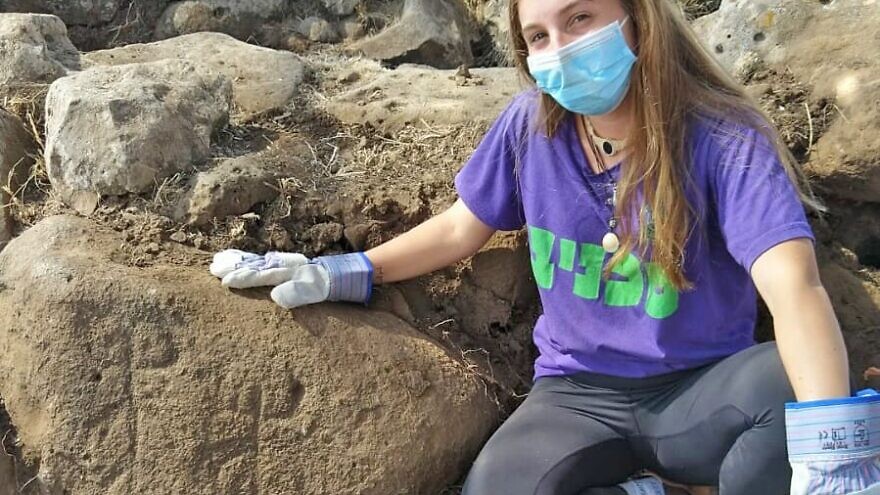
Ofri Eitan of the Kfar Hanasi pre-military academy next to the engraved stone at the site of the ancient fortified building complex uncovered in the Golan Heights, November 2020. Credit: Tidhar Moav/Israel Antiquities Authority.
A fortified building complex from the time of King David has been discovered in the southern Golan Heights, the Israel Antiquities Authority (IAA) announced on Wednesday.
The archaeologists who uncovered the complex during IAA excavations in Moshav Haspin assess that it was a fort built by the Kingdom of Geshur (Iron Age, 11th-10th centuries BCE).
According to IAA excavation directors Barak Tzin and Enno Bron, the fortified structure was built strategically on a hilltop above the Nahal El Al Reserve and encompassed by 5-foot-thick walls made of basalt boulders.
“In the excavation, we were astonished to make a rare and exciting find: a large basalt stone with a schematic engraving of two horned figures with outspread arms,” they said.
The IAA noted that a similar horned figure with outstretched arms was discovered on a cultic stone stele—uncovered last year during the Bethsaida Expedition Project, just north of the Sea of Galilee—next to a raised platform adjacent to the city gate. Since the Haspin stone was situated on a shelf next to the fort’s entrance, with two such horned figures depicted on it, the archaeologists speculated that “a person who saw the impressive Bethsaida stele [may have] decided to create a local copy of [it].”
The IAA explained that Bethsaida, a fortified city, is considered by scholars to have been the capital of the Aramean Kingdom of Geshur, which ruled the central and southern Golan 3,000 years ago. The Bible recounts that the kingdom enjoyed diplomatic relations with the House of David and that one of David’s wives was Maacah, the daughter of Talmi, king of Geshur.
According to the IAA, while cities of the Kingdom of Geshur, such as Tel En Gev, Tel Hadar and Tel Sorag, are known to have existed along the shores of the Sea of Galilee, hardly any such sites from the Iron Age have been found in the Golan Heights. The discovery of the Haspin complex is thus spurring new research in the area.
No comments:
Post a Comment